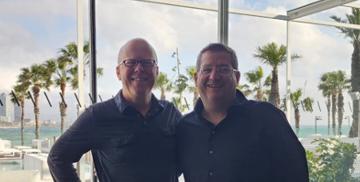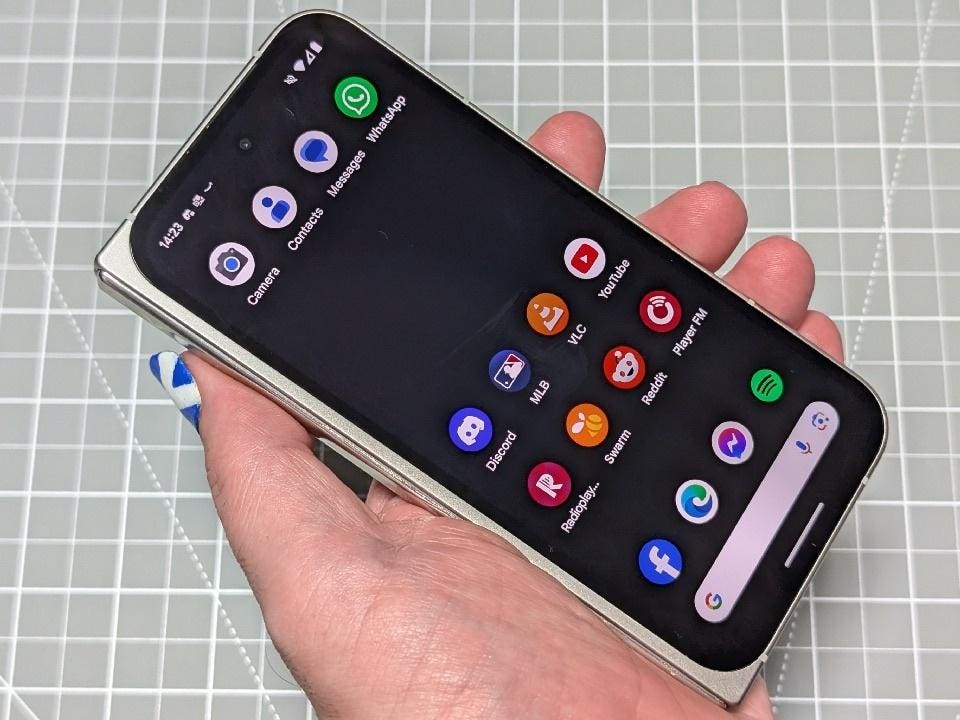Will Townsend and AST SpaceMobile CEO Abel Avellan, March 2025
Traveling to Barcelona at the end of the winter season to attend Mobile World Congress has become an annual ritual for me over the past decade. In years past, I have tried my best to inventory the vast number of briefings, dinner conversations and announcement insights — but it’s too much. This year, I am talking a different approach, and specifically offering some balance to the industrywide hype about AI and its impact on radio network infrastructure. Yes, AI is helping carriers and equipment vendors reimagine customer support and overall network operations, but I’ve written about that extensively, plus there is just so much else going on in the industry.
In this piece, I will highlight three noteworthy announcements, three companies to watch and three video recordings that I hosted at the event through Six Five Media. Let’s dive in!
Three Noteworthy Announcements At MWC
Many established players in networking, telecommunications and related fields use MWC as a showcase for their biggest announcements, and this year’s event was no different.
HPE Aruba Networking Introduces New Telco-Grade Switch
HPE Aruba Networking keeps refining its private cellular networking platform, with the new CX 8325P switch as the latest piece of that puzzle. Modern AI workloads that include both generative and agentic AI applications present a significant monetization opportunity for operators and communication service providers, especially as they move to network edges. The CX 8325P is built to handle these demands. The company says it is the first solution that embeds precision timing into the network fabric that facilitates nanosecond accuracy for improved quality of calls, data transactions and latency-intensive workloads. It’s also noteworthy that HPE uses a single operating system designed to ease not only deployment, but also ongoing management.
In Barcelona, I got to speak with HPE executives, including my good friend Phil Mottram, who leads HPE Aruba Networking, and the company’s Athonet core infrastructure leadership. From those conversations, it’s clear that HPE is busy bringing the management plane function of both its Wi-Fi and cellular solutions together in a single dashboard. Once that effort is complete later this year, it could significantly accelerate HPE’s private networking offering by eliminating the complexities of network overlays.
AMD, Cisco, Nokia And Reliance Jio Join Forces For Open Telecom AI Platform
I was one of just a few media members and industry analysts given the opportunity to attend this announcement in person, and I walked away impressed. Broadly speaking, the initiative is the brainchild of Mathew Oommen, chief executive of Jio Platforms Limited. Oommen’s vision is to democratize the access to modern AI applications in places that are macroeconomically challenged, including his home country of India. It’s a bold and ambitious endeavor, especially given the expense of costly GPUs that are used for training cloud-hosted large language models. However, Jio has demonstrated a capability to lean into disaggregation, virtualization and open platforms to build its mobile networks at speed and scale. I have little doubt that the operator can execute on its mission, given this impressive set of partners and Reliance Jio’s own success in building a subscriber base of nearly half a million customers.
AST SpaceMobile And Vodafone Group Launch Joint Venture
Dubbed “SatCo” (at least for now), this partnership aims to facilitate ubiquitous geographic cellular mobility coverage in Europe. I like this formation of a single entity to efficiently service the highly fragmented landscape of mobile service providers within individual countries throughout the European Union. The new venture aims to provide a turnkey solution supported by a fully managed networking stack and operations that address the need for digital sovereignty.
I spent time with AST SpaceMobile’s chief executive Abel Avellan towards the end of the event, and we discussed several potential use cases for SatCo’s services beyond the obvious ability to use low earth orbit satellite connectivity for remote terrestrial network gap coverage. Three examples of this potential are dramatically improved connectivity services on commercial aircraft, support for large-scale agricultural technology deployments to improve crop and livestock yields and, eventually, widespread autonomous driving. This extensibility of AST SpaceMobile’s technology stack shows how it reaches well beyond simple SOS text messaging, such as the Business Direct to Cell service currently offered by its rival Starlink.
Three Companies To Watch
Because of all the attention MWC draws each year, it’s also a natural venue for companies that aren’t (yet) household names to make their mark. Here are three that stood out for me.
Getting Hyperlocal With floLIVE
London-based floLIVE claims to operate the largest “hyperlocal” and global data network on the planet. Hyperlocal refers to the company’s ability to provide connectivity quickly and efficiently anywhere in the world. The company offers a full suite of connectivity solutions including an end-to-end IoT connectivity platform, a cloud-managed 4G LTE and 5G private network offering, a global network-as-a-service solution and business support systems intended to provide the flexibility for operators to launch new business models and monetization opportunities. I spent time with floLIVE executives at MWC, and left impressed with the potential that the company has — thanks to both the growth of industrial IoT within manufacturing automation use cases and the growth of private networking in general.
Is This Inseego 3.0 We’re Seeing?
One could argue that MWC marked Inseego’s 3.0 reinvention. The company’s identity is invariably tied to cellular Wi-Fi hotspots with its MiFi products, providing an incredibly strong anchor point and brand recognition for it to push into fixed wireless access and mobile edge solutions. However, Inseego has stumbled in recent years because of a focus on telematic services that proved to be a distraction. That has changed now with the sale of those assets and the recent announcement of Juho Sarvikas as its new chief executive. Sarvikas brings a wealth of experience and success to Inseego, having served as president of Qualcomm’s North American business unit.
After visiting with Sarvikas and his leadership team at the event, I left impressed with his pragmatic vision to reinvigorate Inseego’s opportunities to capitalize on the power of 5G, including a recent announcement to adopt Qualcomm’s newly minted Dragonwing FWA Gen 4 Elite platform in Inseego’s new FX5000 5G cellular router.
Spectrum Effect Helps Operators Make The Most Of Licensed Spectrum
Spectrum Effect offers an innovative platform that provides network operators with granular visibility into RAN interference detection and offers fine-tuning capabilities powered by an AI-RAN operations engine. By leveraging AI and automation, the company is helping service providers maximize the use of one of their most valuable assets — licensed spectrum. From my perspective, Spectrum Effect may be one of the telecommunications industry’s best-kept secrets, but that will change soon. Telco industry veteran Shaun McCarthy joined nearly one year ago as its president and chief revenue officer, having served in prior senior leadership roles at Nokia and Cisco.
I know McCarthy on a personal basis, and I believe his historic focus on customer experience and his understanding of operator pain points (especially around managing subscriber churn and operational expenses) have the potential to set the company up for further success.
Three Video Recording Highlights
During the several days I was in Spain, I had a chance to sit down on camera with technical and business leaders from different tech providers to discuss the new contributions their companies are bringing to market. Here are three of my favorite conversations.
Palo Alto Networks Launches Prisma SASE 5G Solution
What I like about Palo Alto Networks’ new SASE 5G offering is its ability to complement 5G’s encryption improvements over 4G LTE while also providing another avenue for service provider monetization to balance the costly investment in cellular infrastructure and licensed spectrum. This Six Five Media video goes deeper into the details of the Palo Alto Networks solution.
Intel Continues To Make Telecom Contributions
I was glad to dive deeper into what Intel is doing in terms of network functions virtualization, AI acceleration and edge enablement. My guests and I also discussed Intel’s ecosystem efforts with partners including Ericsson, Nokia and Samsung; the companies are collaborating to drive new levels of innovation and unlock value for customers based on open standards. This video highlights the telecom workload capabilities of Intel’s Xeon 6 and more.
Ericsson Leads The Charge For Network Programmability
Ericsson continues to focus on network programmability, as well as helping operators move to 5G Standalone to unlock the true potential of 5G. This means enabling network slicing, AI optimized RAN, enterprise FWA, private networking and more. Ericsson did a lot to demonstrate its leadership in many areas at MWC, and this video goes deeper into the company’s efforts.
MWC Broadens Its Focus And Reach
Attendance at MWC Barcelona 2025 was at an all-time high, and the audience demographics are shifting, with an emphasis on enterprise connectivity services. This is not a surprising development, especially given the rising adoption of private cellular networking and AI use cases that have the potential to leverage both wired and mobile networks. My prediction is that the next killer application for 5G beyond FWA could be enabling generative and agentic AI applications at the network edge. Time will tell if my prediction is valid, but one thing is certain: connectivity continues to be instrumental in facilitating both telecom and enterprise digital transformation.
Moor Insights & Strategy provides or has provided paid services to technology companies, like all tech industry research and analyst firms. These services include research, analysis, advising, consulting, benchmarking, acquisition matchmaking and video and speaking sponsorships. Of the companies mentioned in this article, Moor Insights & Strategy currently has (or has had) a paid business relationship with AMD, Cisco, Ericsson, HPE, Inseego, Intel, Nokia, Palo Alto Networks, Qualcomm and Samsung.








